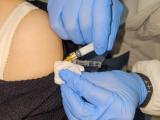A pair of reports that provide an annual snapshot of childhood immunization trends shows that the vaccine exemption rate for kindergarteners rose for the third year in a row and vaccine coverage for children younger than 3 was high and stable for most vaccines.
The reports, from teams led by US Centers for Disease Control and Prevention (CDC), appear today in the latest issue of Morbidity and Mortality Weekly Report (MMWR).
Kindergarten levels show regional variation
For the analysis of immunization rates in kindergarteners, researchers looked at data on childhood vaccine coverage for each state for the 2018-19 school year. Overall coverage was 94.7% for two doses of measles, mumps, and rubella (MMR) vaccine, up slightly from 94.3% reported for the previous year. Levels were 94.9% for state-required diphtheria and tetanus toxoid and acellular pertussis (whooping cough) vaccine, down slightly, and 94.8% for varicella (chicken pox) vaccine, reflecting a slight increase.
Taken together, coverage for the three vaccines remained near 95%, but the team found that coverage varied by state. For example, for the MMR vaccine, coverage ranged from 87.4% in Colorado to more than 99.2% in Mississippi. Coverage met or topped 95% in 20 states, and 2 states were below 90%.
Measles outbreaks in states with high coverage, such as New York, highlight the need to assess vaccination patterns at the local level, and the CDC encourages health officials to use their local data to identify pockets of undervaccinated students.
Meanwhile, the percentage of kindergarteners with an exemption to one or more required vaccines was 2.5%. That metric also varied by state, with Mississippi reporting the lowest exemption rate (0.1%) and Idaho and Oregon reporting the highest (7.7%).
The level was slightly higher than the 2.3% reported for the 2017-18 school year and 2.1% reported the year before that.
In a breakdown of types of exemptions, 0.3% of kindergarteners had medical exemptions and 2.2% had nonmedical ones.
Though the overall percentage of kids with vaccine exemptions increased again, the authors said the unvaccinated group still represents a small proportion of kindergarteners and that in 25 states, the number of nonexempt undervaccinated kids exceeded the number of those with exemptions.
The findings can help guide strategies to counteract vaccine misinformation messages and systems to follow-up on undervaccinated children to ensure that they are immunized, the study authors said.
Uptake trends in toddlers
To estimate vaccine coverage for toddlers, the researchers combined 2016-2018 data from the National Immunization Survey-Child on kids born in 2015 and 2016. Coverage was more than 90% for three or more polio vaccine doses, one or more MMR dose, three or more hepatitis B doses, and one more varicella dose.
Compared with children born in 2013 and 2014, coverage for the current younger group increased for the birth hepatitis B vaccine dose, as well as one or more doses of hepatitis A vaccine and two or more doses of flu vaccine.
The estimates also suggest, however, that kids were least likely to be up to date by age 24 months for two or more doses of flu vaccine and the combined seven-vaccine series.
Overall, uninsured children and those with Medicaid or other nonprivate insurance had lower vaccine coverage rates than children who had private insurance.
Looking at the big picture, the authors said the proportion of children who received no vaccinations by age 2 has increased slightly across 2011 through 2016 birth years, with an estimated change of 0.09 percentage points each year.
Only 1.3% of children born in 2015 or 2016 received no vaccinations. Though the percentage is small, researcher said the patterns—including coverage gaps by insurance status, poverty level, and rural residence status—underscore several opportunities for improvement. For example, they said efforts to promote the Vaccines for Children program, which offers no-cost vaccine to eligible children, might not be reaching the at-need populations and could be modified.
"Targeted programs to address logistical issues such as expanded office hours and transportation to vaccination appointments could facilitate access to vaccination services, regardless of the child's type of insurance," they wrote, adding that they encourage providers to use every patient encounter to screen for and offer vaccines.
See also:
Oct 17 MMWR report on immunizations in kindergarteners
Oct 17 MMWR report on immunizations in kids younger than 3





















